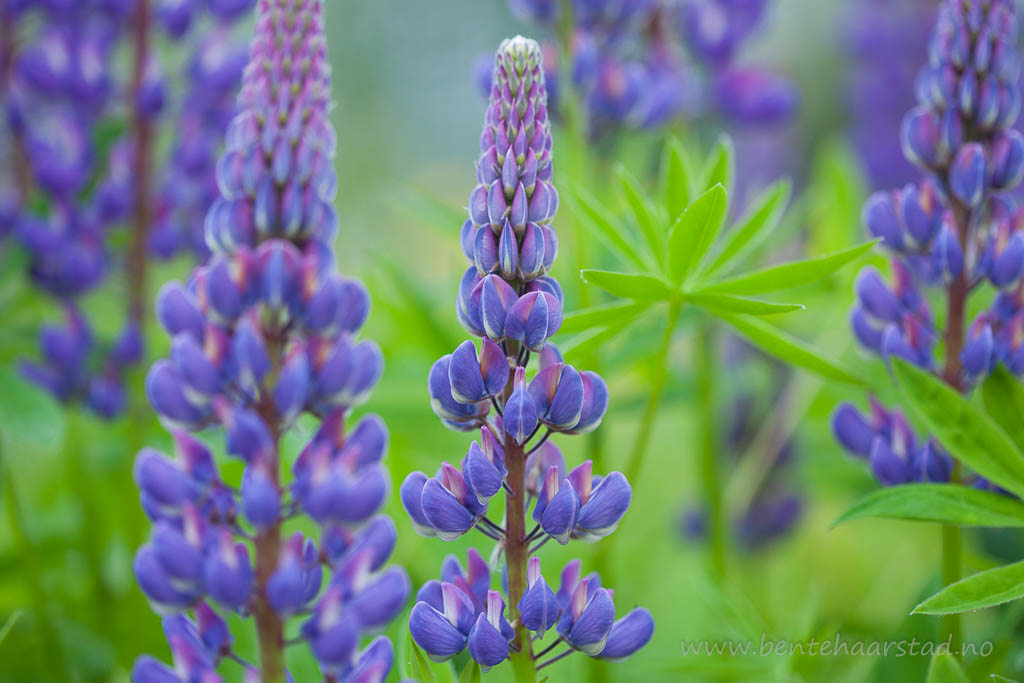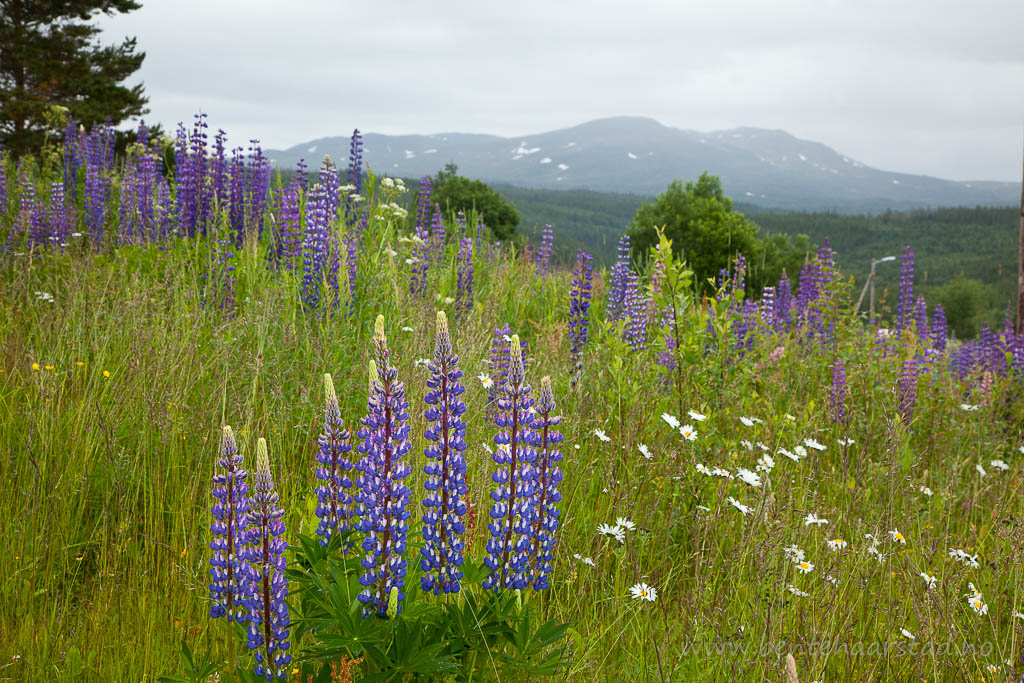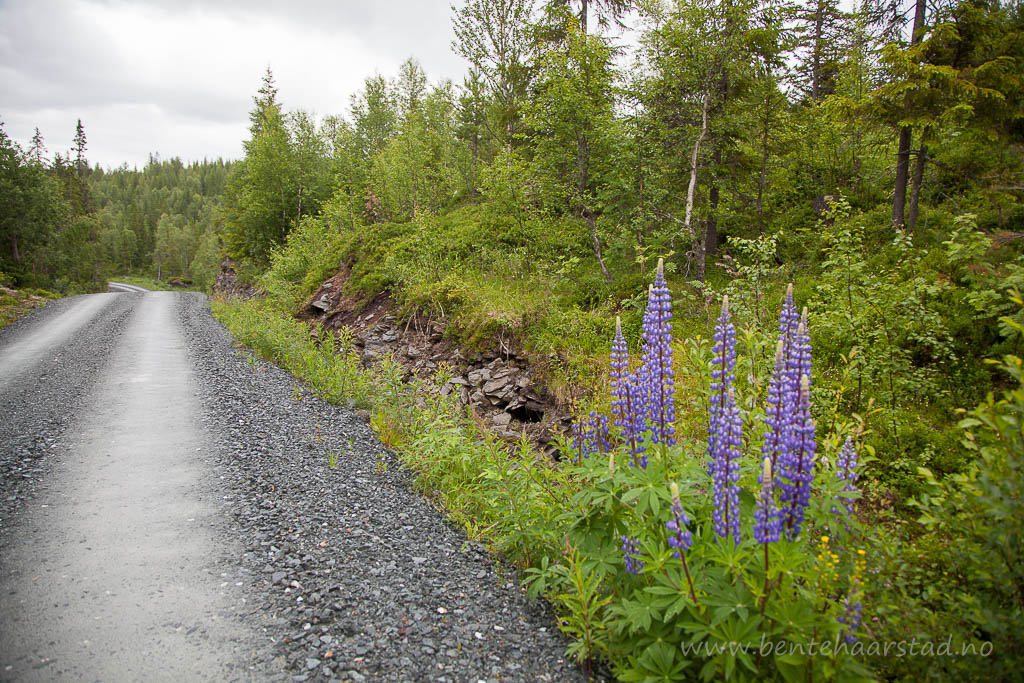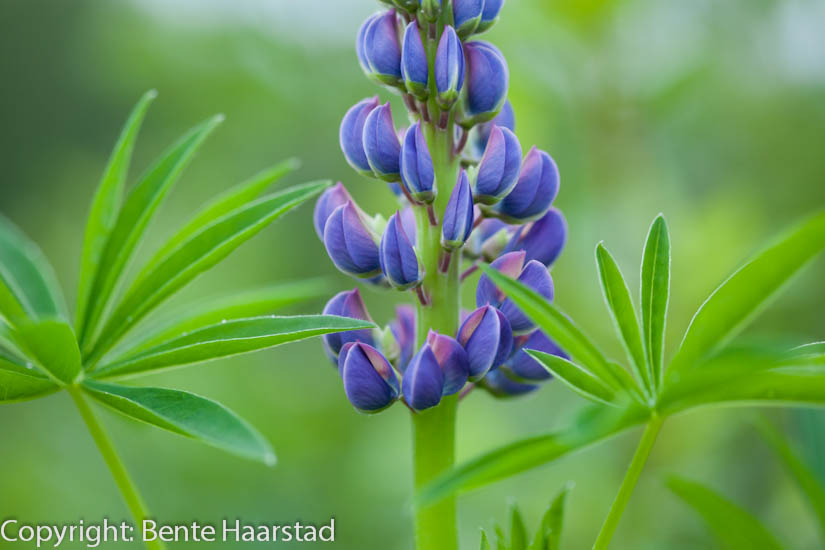
Lupins are such beautiful flowers, and I really enjoy to see them. Nevertheless, I will sometimes destroy them when I see them, if I can. The reason is they are among the alien invasive species that do harm in our nature, and they were blacklisted in 2007. By then they were almost all over the country. In many cases it was our road authorities that spread the lupins, to make the road edges look nice. We have three species, and they all originates from North America; Lupinus polyphyllus, Lupinus nootkatensis and Lupinus perennis. I can’t distinguish between them, but maybe you can?

I often see beautiful pictures of lupins in the nature where they belong, from fellow American bloggers. In the picture above, in a Norewegian mountain village, they don’t belong, and they soon get so many that the native species will not have a chance to grow. Typically they take the space from our native hare bells and oxeye daisies among others.

In a case like this the lupins should definitely be removed. It is still just a single plant, and if not removed, it will soon spread to the nature. According to our authorities we are allowed to remove alien species from the nature when we see them, and I think we all should do, when we can. It is similar to removing plastic bottles or tin cans, when we see them in the wrong place. But sometimes the plants are too many. It is too late, at least without a great effort removing them.

We are not even recommended to keep lupins in our gardens anymore, because they can jump the fence, with or without our help. And our authorities are very serious about invasive species. Here is a list of some of them. If you destroy and remove such plants, from your garden or from nature you can bring them to places for recycling, but if so placed in a sealed plastic bag and delivered to a separate container. They can be composted in your own garden of course, with consideration. These plants reproduce with seeds, a lot of seeds. There are some more pictures Link to my photos of blacklisted plants in Norway.

mind freshing pictures
LikeLike
Thank you, I am glad you like them San Jeet.
LikeLiked by 1 person
They are so beautiful! It is amazing that you have to destroy them there, and over here I go up into the mountains in spring just to see them because they are quite rare in Arizona.
Pick armsful and enjoy them in vases all through your house. That will destroy them and give you some beauty for a little while.
We don’t pick them here because they are so rare!
LikeLiked by 3 people
You definitely shouldn’t pick them if they are rare, just enjoy. I guess you have native lupins in Arizona. They are beautiful plants, take good care of them. Our nature can’t cope with them and thay have become an ecological hazard. I doesn’t help to pick armsful, Emilie, but thanks for your advise and for sharing your experience.
LikeLike
I think it’s a great idea that you’re making us aware of those plants that harm the native species! I think too many people aren’t aware of them (at least I wasn’t).
The photos are beautiful though 🙂
LikeLike
What a shame. I love lupins. Seems like every time there is too much of one kind of plant we are told to destroy it.
LikeLiked by 1 person
The lupins in my Scottish garden were eaten by slugs so perhaps nature is fighting back.
LikeLike
Great images, Bente 😀
LikeLike
They look so pretty Bente. Surprising though how ugly anything becomes when it launches such a massive and indiscriminate takeover.
LikeLiked by 1 person
Beautiful photos from beautiful flowers Bente, sometimes there are to many and must be destroyed, also the flowers are poisonous for animals. I love your blog, but you are right, anough is anough! Greetings, Ann.
LikeLike
LikeLiked by 1 person
Good effort Bente.
In most of the case, on the early stage, people appreciate new and rare foreign flower.
Then the people start to act against the alien species when it was too late.
I don’t see lupines other than in a garden in england.
= It’s mean, the Norwegian case, it must be intentionally spread by the humans on the beginning.
LikeLiked by 1 person
Your photos are magnificent, and I love lupins too. A pity they are invasive.
LikeLike
I agree that it is a mistake to introduce non-native plants because they do tend to take over. We have quite a few that seem to be wiping out native plants because the conditions apparently favor the non-natives to proliferate. Out biggest battle locally is gorse, introduced from Scotland. Here, the gorse takes over and has foiled all efforts to eradicate it.
LikeLiked by 1 person
Fascinating … I had no idea. They really ARE beautiful, & I’m glad you shared their loveliness with us before you destroyed them… Best of both worlds! 🙂
LikeLike
I agree that alien invasive species must be controlled and there are quite a few here that need such action. On the other hand, some of them are so lovely, like lupines, that I don’t mind them taking over depending on where that is. We have one native lupine here which I blogged about in this post. In other locations the alien lupines are mostly found but of all the aliens they are not causing much trouble.
LikeLiked by 1 person
Lovely images, Bente. The lupins are very invasive indeed. I know they are on the blacklist so during my stay in Norway I was very much on the lookout for the lupins. Amazingly, most of them are on the roadsides.
LikeLike
Very good set!
LikeLike
I like lupines but to much is to muchBente
LikeLike
We have a problem in Australia with Lantana. Here it is a noxious weed that spreads far and wide. I smile when I see it sold in nurseries in Italy where it is considered exotic. I think the cold winters must keep it in check there.
LikeLike
Lupins are beautiful but we know your concerns. The Lupinus polyphyllus is also invasive in New Zealand.
LikeLike
Beautiful, but I can well understand the need to remove them before they take over completely.
LikeLike
so colorful and beautiful 🙂
LikeLike
I didn’t know that these lupins were so invasive. We have a similar issue with bamboo. If left to its own devices, bamboo can quickly take over your yard — and your neighbor’s too!
LikeLike
Water hyacinth is our trouble. They are so beautiful in bloom, but they can clog waterways and take up oxygen. I confess I’d have a hard time tearing out lupines. They are so rare here, and they are so beautiful. I understand, but if they were in my yard, I’d certainly go the route of picking many, many bouquets.
LikeLike
The lupines are in bloom here in Maine now. They are beautiful, but as you say, they simply claim all available territory for themselves.
LikeLike
Beautiful but invasive, as you say. A lot of the commonest flowers found at roadsides here in Britain are invaders: Oxford ragwort, Rosebay willowherb, Himalayan balsam etc.
LikeLike
Yes, we often learn all too late about these species. Like loosestrife here, they are pretty but not worth the price…
LikeLike
These photos are amazing!
LikeLike
Colorful and nice photos. Saludos.
LikeLike
Haughtiness. Here I saw lupins only in gardens, ever in the middle of nowhere. It is really beautiful and i’m surprise to see it’s a invasive species. Good day to you Bente.
LikeLike
We have a whole catalogue of invasive species in Australia. Blackberries and gorse are among the chief offenders around Castlemaine where I live. Lupins are well behaved keeping to their gardens.
LikeLike
Such a beautiful flower! What a shame they have to be destroyed, but I understand the problem: it happens everywhere.
LikeLike
Beautiful photos and thought provoking narrative, thank you for sharing this.
LikeLike
Wow, it’s good to know this! Interestingly enough, I believe oxeye daisies are an equivalent problem in places in the US, yet how beautiful they are where they “belong.” One of my favorite paintings, which I believe depicts a field of oxeye daisies(?), is Harald Sohlberg’s Flower Meadow in the North https://commons.wikimedia.org/wiki/File:Harald_Sohlberg_-_Flower_Meadow_in_the_North_-_Google_Art_Project.jpg.
LikeLike
i like the first picture very much.
LikeLike
Really good post with strong images.. quite interesting that they’re invasive in your neck of the woods. The deer have eradicated most of ours.
LikeLike
beautiful flowers!
LikeLike
I didn’t realise the lupins were such a serious problem in Norway. There are a few places they grow wild in Spain, but as someone already commented, in the UK we have problems growing them in gardens as slugs and snails love to eat them.
LikeLike
Such a beautiful flower, and lovely photographs. Sorry to read that it’s invasive in your country. In North America, purple loosestrife (Lythrum salicaria, native to Europe) takes over wetlands and crowds out native plants. The solution has been to import a beetle from Europe that feeds on loosestrife – and the beetle appears to be controlling it.
LikeLike
We also have problems with invasive species of plants here in Germany. Its
a worldwide phenomena, I think. The beautiful lupins grow in my garden! 😉
LikeLike
What is invasive differs among the countries. I don’t think lupins are native to Germany either, but they don’t have to be a problem if they are not invasive in nature. Theu can be very beautiful in gardens, that is for sure. Thanks Chris.
LikeLike
Thanks for sharing these amazing photos.
LikeLike
Thanks for visiting Lonelyauthor.
LikeLiked by 1 person
My pleasure.
LikeLike